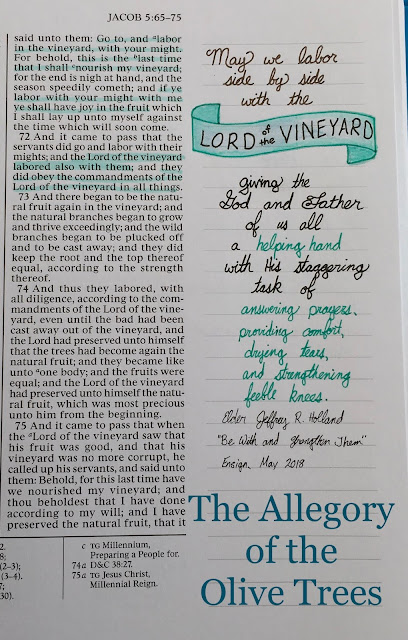In the margin on the first page, I wrote down everything we know about the mysterious prophet Zenos and a lengthy quote comparing the olive tree to the Biblical tree of life.
Who was Zenos?
A Hebrew prophet whose writings appeared on the brass plates but who is not mentioned in the Old Testament. He lived sometime after the prophet Abraham and before the prophet Isaiah (see Hellman 8:19-20). We know he testified concerning the death and redemption of the Son of God (see 1 Nephi 19:10; Alma 8:19). (Book of Mormon Student Manual, chapter 16: Jacob 5-7).
"One writer has said of this extended symbolic portrayal, 'One Jewish legend identifies the tree of life as the olive tree, and with good reason. The olive tree is an evergreen, not a deciduous tree. Its leaves do not seasonally fade or fall. Through scorching heat and winter cold they are continually rejuvenated. Without cultivation the olive tree is a wild, unruly, easily corrupted tree. Only after long, patient cultivating, usually 8-10 years, does it begin to yield fruit. Long after that, new shoots often come forth from apparently dead roots. [The appearance of gnarled trunks gives] the impression of travail-of ancient life and renewing life,'" (Truman Madsen, "The Olive Press: A Symbol of Christ," in The Allegory of the Olive Tree, ed. Stephen D. Ricks and John W. Welch, 1994; as quoted in Book of Mormon Student Manual, chapter 16: Jacob 5-7).
On the next page I put the header "The Scattering of Israel":
"The olive tree is the House of Israel. In its native land it began to die. So the Lord took branches like the Nephites, like the lost tribes, and like others that the Lord led off that we do not know anything about, to other parts of the earth. He planted them all over his vineyard, which is the world," (President Joseph Fielding Smith, Answers to Gospel Questions, 4:204, as quoted in Book of Mormon Student Manual, chapter 16: Jacob 5-7).
I love this next one so much more than those scholarly quotes, because it reminds me of what matters most:
"Jesus suffered in Gethsemane, the place of the olive press," (Elder D. Todd Christofferson, "Abide in My Love," Ensign November 2016).
I penciled in the olive branches that surround the quote, then traced the branches with gray Mildliner highlighter. The leaves and olives are an aqua blue.
On the facing page is a quote from Elder Holland. He has a spiritual gift for speaking straight to the heart of the matter, and can turn even the repetitiveness of this allegory into a heart-rending story. "After digging and dunging, watering and weeding, trimming, pruning, transplanting, and grafting, the great Lord of the vineyard throws down his spade and his pruning sheers and weeps, crying out to any who would listen, 'What could I have done more for my vineyard?' What an indelible image of God's engagement in our lives! What anguish in a parent when His children do not choose Him nor 'the gospel of God,'" (Elder Jeffrey R. Holland, Ensign, November 2003).
On the next page of Jacob 5, the scattered branches of the olive tree are being gathered back in. I gave this page the title "The Gathering of Israel," and found a recent quote from President Nelson about the importance of the gathering:
"The cause of the gathering is an essential part of helping to prepare the world and its people for the Second Coming of the Lord," (President Russell M. Nelson, "Witnesses, Aaronic Priesthood Quorums, and Young Women Classes, Ensign, November 2019).
Who is the "Lord of the vineyard?" Our Heavenly Father. Many times in our stubbornness, we fail to see Him for who He is: our loving eternal Father.
"May we labor side by side with the Lord of the vineyard giving the God and Father of us all a helping hand with His staggering task of answering prayers, providing comfort, drying tears, and strengthening feeble knees," (Elder Jeffrey R. Holland, "Be With and Strengthen Them," Ensign, May 2018).
The ending of the allegory parallels what will happen in the Millennium. Don't you just love this quote from Elder Christofferson?
"This great and last dispensation is building steadily to its climax-Zion on earth being joined with Zion from above at the Savior's glorious return," (Elder D. Todd Christofferson, "Preparing for the Lord's Return," Conference April 2019).
In Jacob 6, we get the simplest of advice from the prophet Jacob:
"O be wise; what can I say more?" (Jacob 6:12).
And in chapter 7, Jacob contends with Sherem, the anti-Christ. Like Jacob, we will meet many philosophies in our day that attack our faith. May our testimonies be so strong that we will able to say, along with Jacob:
"I could not be shaken," (Jacob 7:5).
Looking for other chapters? See my "Directory of Book of Mormon Posts." Or you may want to follow my Pinterest board, Book of Mormon Journaling.










No comments:
Post a Comment